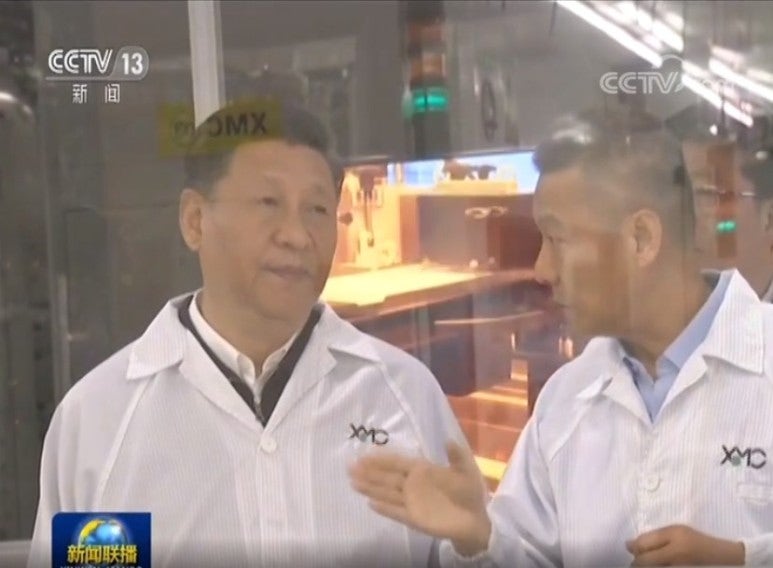
How long can Korea’s semiconductor leaders, Samsung Electronics and SK hynix, maintain their global dominance? That question is gaining urgency as China’s so-called Red Memory trio — Semiconductor Manufacturing International Corporation (SMIC), Yangtze Memory Technologies (YMTC) and ChangXin Memory Technologies (CXMT) — rapidly close the gap, posing a serious challenge to Korea’s chip supremacy.
SMIC, dubbed “China’s TSMC,” is expanding its foundry business despite U.S. sanctions, building a self-reliant supply chain through close cooperation with Huawei. According to market tracker Counterpoint Research, SMIC held a 5 percent share of the global foundry market in the third quarter of this year, trailing closely behind Samsung’s 8 percent.
In NAND flash memory, YMTC began mass-producing 270-layer 3-D NAND chips earlier this year, narrowing the technology gap with SK hynix’s 321 layers and Samsung’s 286 layers. The company is expected to leapfrog to 400-layer NAND in the second half of next year, skipping the 300-layer milestone entirely. YMTC also plans to go public early next year.
In the DRAM sector, CXMT is shaking up the market by selling previous-generation DDR4 chips at roughly half the price of competitors. Industry observers say the current three-way dominance by Samsung, SK hynix and U.S. chipmaker Micron may soon collapse.
Korean companies themselves predict that Chinese memory chipmakers could overtake them within five years. A broader concern is that China could surpass Korea in all 10 of its top export industries — including shipbuilding, information technology, petrochemicals and biotech — by 2030.
The Federation of Korean Industries (FKI) released a report on Monday with the results of a survey of 200 companies in Korea’s 10 core export sectors on where the country’s competitiveness stands compared to the United States, Japan and China. It concluded that by 2030, China is projected to outpace Korea in every single one.
The industries surveyed were semiconductors, displays, steel, electronics, automobiles and parts, general machinery, shipbuilding, secondary batteries, petrochemicals and biopharmaceuticals.
The report assessed Korea’s current competitiveness as a baseline score of 100. China scored 102.2, higher than Japan’s 93.5 but below the United States’ 107.2. In five years, China’s score is expected to rise to 112.3, nearing the United States at 112.9.
“Korean firms are already lagging behind the United States and China, and the gap will only widen over the next five years,” said Ryu Seong-won, head of FKI’s industrial innovation team.
Currently, China trails Korea in five sectors: semiconductors, with a score of 99.3; electronics at 99; shipbuilding at 96.7; petrochemicals at 96.5; and biopharma at 89.2. But by 2030, China is projected to overtake Korea in all five, with scores such as 107.1 for semiconductors and 113 for electronics.
Korean shipbuilders like HD Hyundai Heavy Industries and Hanwha Ocean, which have seen rising demand from U.S. clients, may also see their edge eroded. In September, China’s two largest shipbuilders — the China State Shipbuilding Corporation and the China Shipbuilding Industry Corporation — completed a merger, forming the world’s largest shipbuilder with 400 billion yuan ($56.2 billion) in assets and 130 billion yuan in combined operating income.
U.S. competition is also tightening. Currently, the only sectors where Korea holds an edge over are steel, where the United States has a competitiveness score of 98.8; shipbuilding at 90.8; and secondary batteries at 89.5. By 2030, the United States is projected to surpass Korea in steel as well, leaving Korea ahead in just two sectors.
“The six key factors determining corporate competitiveness are price, productivity, government support, skilled labor, core technology and brand power,” said Ryu. “By 2030, China is expected to surpass Korea in all six, and the United States will in five — except productivity.”
Lee Jun, a senior researcher at the Korea Institute for Industrial Economics and Trade, emphasized the need for urgent industrial policy reform.
“In the face of mounting pressure from the United States and China, Korea needs survival-level industrial strategies,” Lee said. “We must restructure toward high-value-added products and design systems to secure highly skilled talent across investment, regulation and research and development.”
This article was originally written in Korean and translated by a bilingual reporter with the help of generative AI tools. It was then edited by a native English-speaking editor. All AI-assisted translations are reviewed and refined by our newsroom.
댓글목록
등록된 댓글이 없습니다.